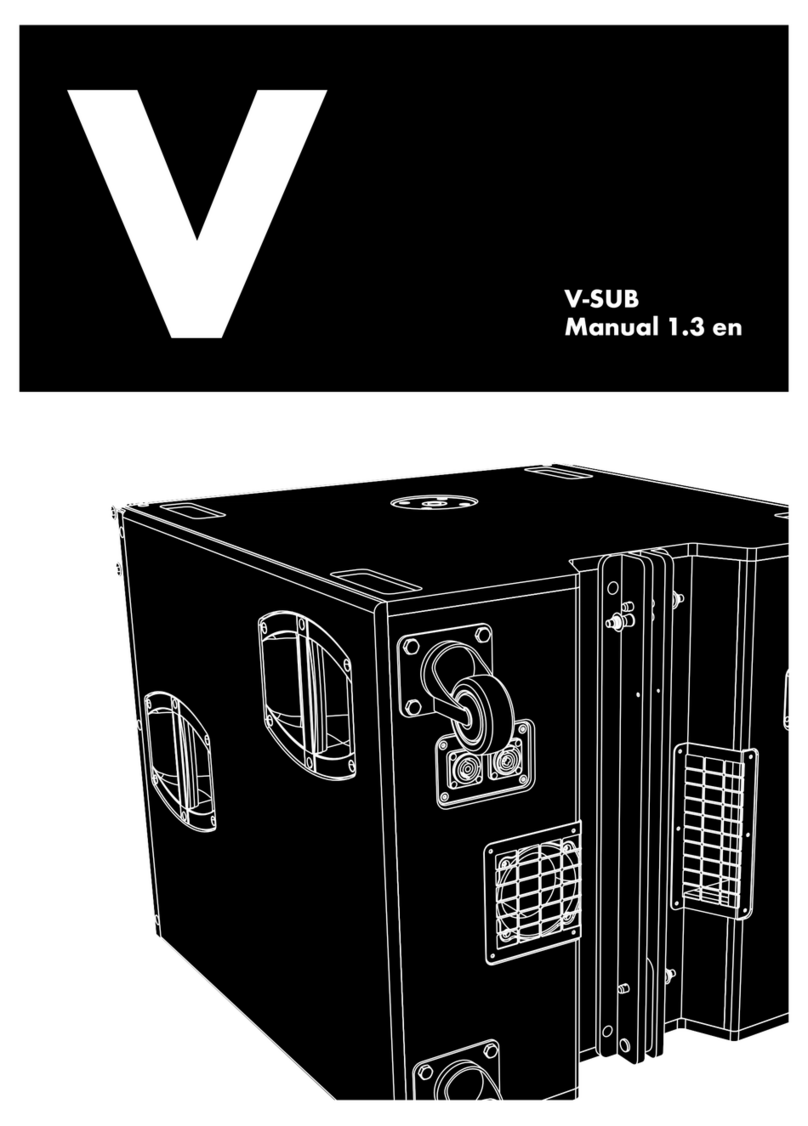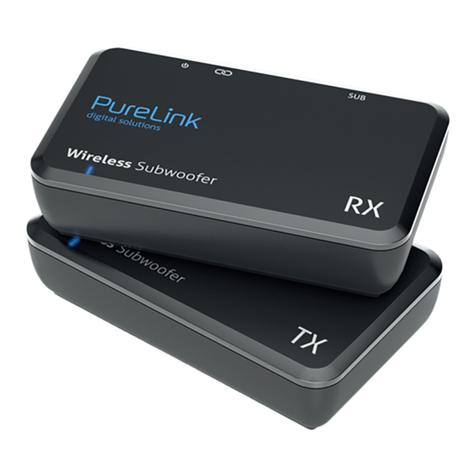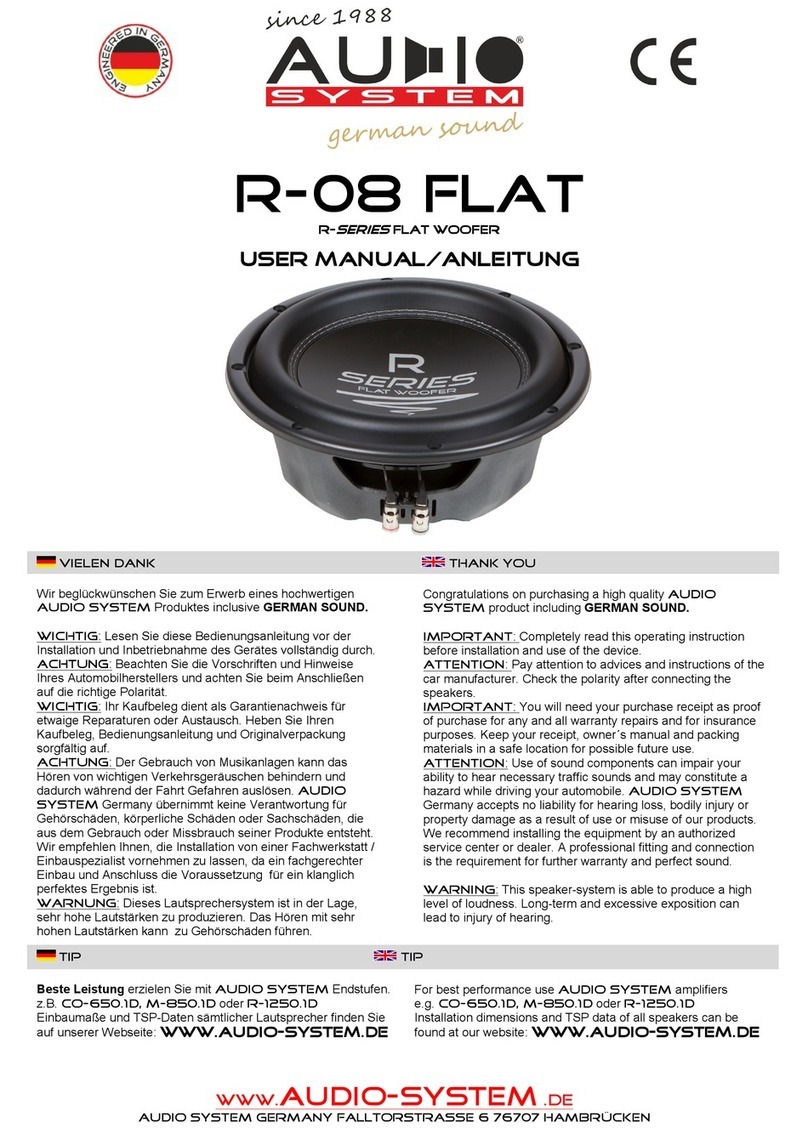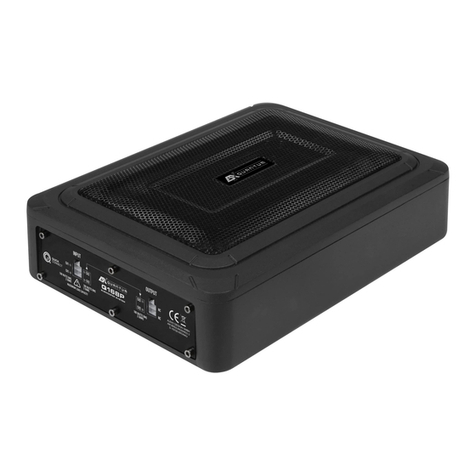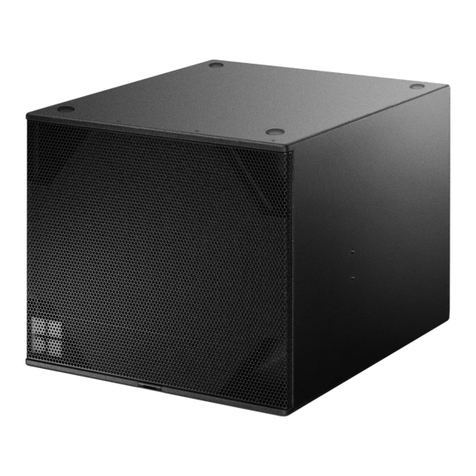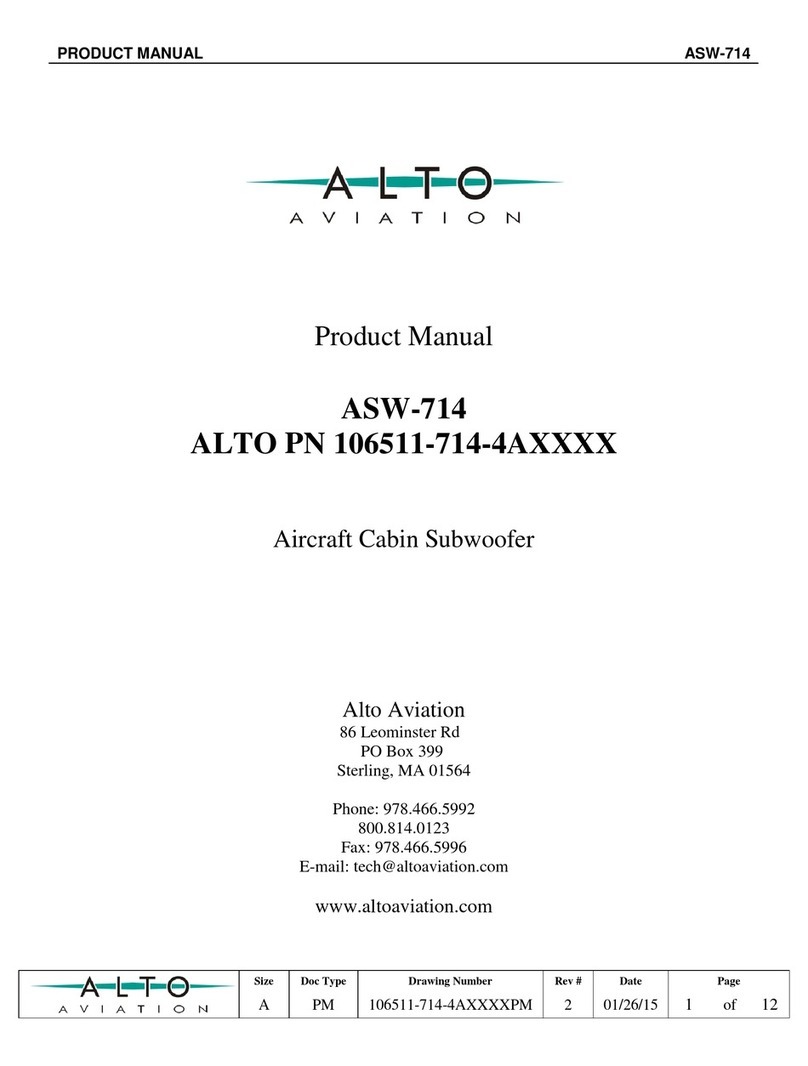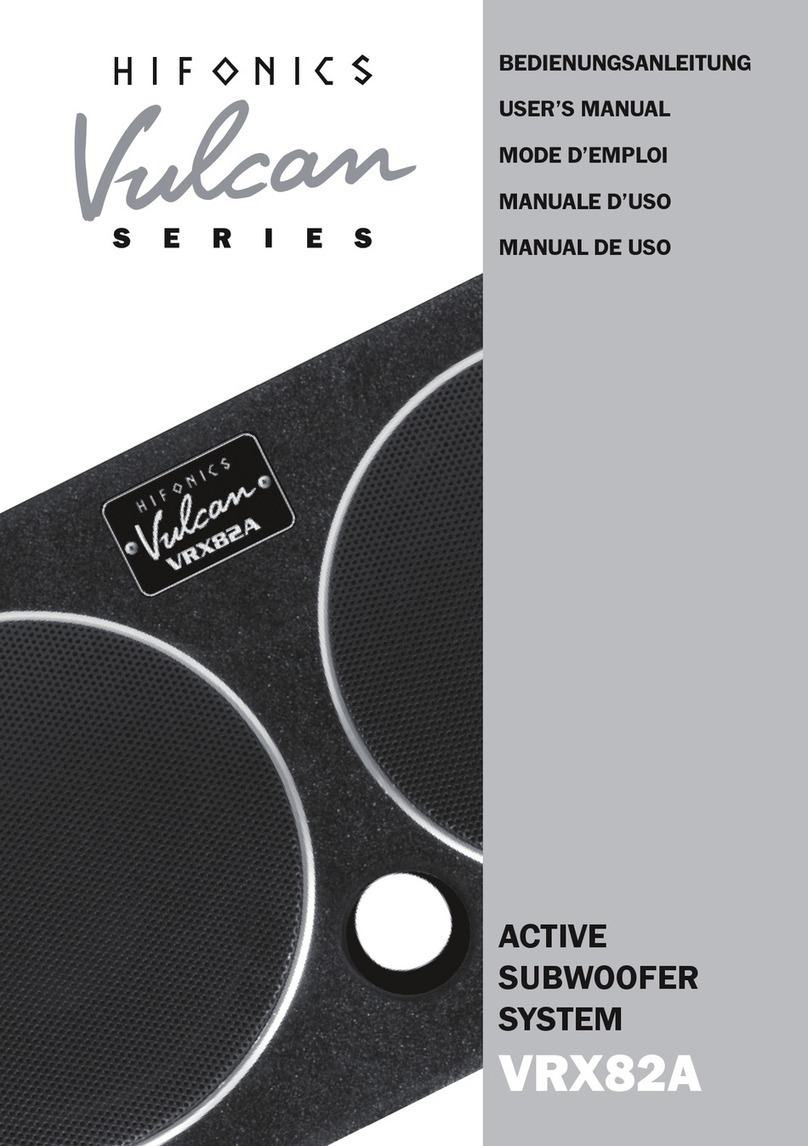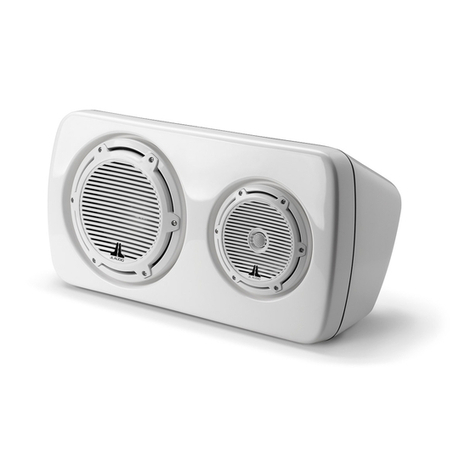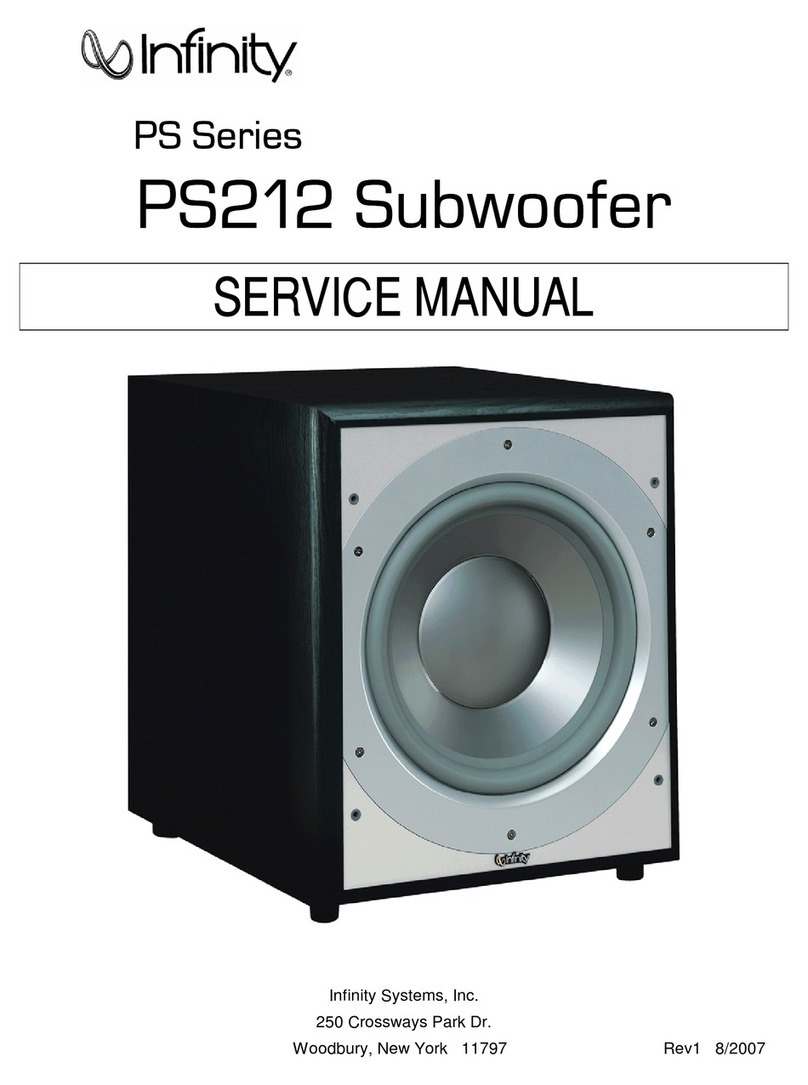D&B Q-SUB User manual

Q-SUB
Manual (2.1E)

References in the manual
WARNING! This refers to a potentially dangerous situation which
may lead to personal injury.
CAUTION! This refers to a potentially dangerous situation which
may lead to personal injury.
IMPORTANT! This refers to a situation which may cause the equipment
to malfunction.
Note: Additional information and/or references.
Symbols on the equipment
Please refer to the information in the operating manual.
WARNING!
Dangerous voltage!
General Information
Q-SUB Manual
Version 2.1E, 11/2004, D2042.E.02
©by d&b audiotechnik AG 2004; all rights reserved.
The information contained in this manual has been carefully checked for
accuracy, at the time of going to press, however no guarantee is given
with respect to the correctness.
d&b audiotechnik AG accepts no responsibility for any errors or
inaccuracies that may appear in this manual or the products and
software described in it.
Technical specifications, dimensions, weights and properties do not
represent guaranteed qualities.
As manufacterers we reserve the right to make alterations and
modifications within the framework of legal provisions, as well as
changes aimed at improving quality.
d&b audiotechnik AG
Eugen-Adolff-Strasse 134, D-71522 Backnang, Germany
Telephone +49-7191-9669-0, Fax +49-7191-95 00 00

Safety precautions
Before you use our products, read the manual carefully
and observe all the safety precautions. They will protect
you and help to avoid equipment failures.
Keep this manual in a safe place so that it is available for
future reference.
If you supply d&b products, please draw the attention of
your customers to these safety guidelines. Enclose the
relevant manuals with the systems. If you require
additional manuals for this purpose, you can order them
from d&b.
Information regarding use of loudspeakers
WARNING! Never stand in the immediate vicinity of loudspeakers driven at a high
level. Professional loudspeaker systems are capable of causing a sound
pressure level detrimental to human health. Seemingly non-critical sound
levels (from approx. 95 dB SPL) can cause hearing damage if people
are exposed to it over a long period.
In order to prevent accidents when deploying loudspeakers on the
ground or when flown, please take note of the following:
When setting up the loudspeakers or loudspeaker stands, make sure
they are standing on a firm surface. If you place several systems on top
of one another, use straps to secure them against movement.
Only use accessories which have been tested and approved by d&b for
assembly and mobile deployment. Pay attention to the correct
application and maximum load capacity of the accessories as detailed in
our specific “Mounting instructions” or in our "Flying system and Rigging
manuals".
Ensure that all additional hardware, fixings and fasteners used for
installation or mobile deployment are of an appropriate size and load
safety factor. Pay attention to the manufacturers instructions and to the
relevant safety guidelines.
Regularly check the loudspeaker housings and accessories for visible
signs of wear and tear, and replace them when necessary.
Regularly check all load bearing bolts in the mounting devices.
CAUTION! Loudspeakers produce a static magnetic field even if they are not
connected or are not in use. Therefore make sure when erecting and
transporting loudspeakers that they are nowhere near equipment and
objects which may be impaired or damaged by an external magnetic
field. Generally speaking, a distance of 0.5 m (1.5 ft) from magnetic
data carriers (floppy disks, audio and video tapes, bank cards, etc.) is
sufficient; a distance of more than 1 m (3 ft) may be necessary with
computer and video monitors.
Q-SUB Manual (2.1E) Safety precautions - 1

Q-SUB
Fig. 1: Q-SUB
The Q-SUB is the subwoofer for the Q-Series. It can be used to
supplement Q1 and Q7 cabinets in various combinations, either flown
or ground stacked. The Q-SUB cabinet is an actively driven bass-reflex
design housing a long excursion 18“ driver, its frequency response
extending from 40 Hz to 130 Hz.
The Q-SUB cabinet is constructed from marine plywood and has an
impact resistant paint finish. The front of the loudspeaker cabinet is
protected by a rigid metal grill, covered with a replaceable acoustically
transparent foam. The cabinet incorporates a pair of handles, and
mounted on the rear panel are two EP5 or NL4 connectors wired in
parallel and four heavy duty wheels. An M20 threaded flange in the top
panel accepts the d&b Z5013 Loudspeaker stand for the deployment of
full range cabinets.
The Q-SUB has a total of 10 sockets in the front grill and side panels to
accept the Z5153 Locking pins 8 mm that connect to the array links of
the Q1 system. Two runners extend from the rear to the front panel of
the cabinet protecting the bottom panel against scratching. Two
correspondingly shaped recesses are incorporated in the top panel of
each cabinet that accept these runners to prevent cabinet movement
when stacking Q-SUBs.
CAUTION! Only operate Q-SUB loudspeakers with a d&b amplifier configured for
the Q-SUB otherwise there is a risk of damage to the loudspeaker
components.
Connections
1
2
3
4
5
1
2
3
4
5
Sense Drive
n.c.
Fig. 2: Connector wiring
The Q-SUB cabinet is fitted with a pair of EP5 connectors. All five pins of
both connectors are wired in parallel. The Q-SUB uses the pin
assignments 3/4 and 5. Pin 5 is used for SenseDrive (only available
when using a D12 amplifier and 5-wire cabling). Pins 1/2 are designated
to Q-Series full range systems. Using the male connector as the input,
the female connector allows for direct connection to additional
loudspeakers.
The Q-SUB can be supplied with NL4 output connectors as an option.
The D12 SenseDrive function is not available when using NL4
connectors. Pin equivalents of EP5 and NL4 connectors are listed in the
table below.
EP5 12345(SenseDrive)
NL4 1+ 1− 2+ 2− n.a.
Tab. 1: EP5 and NL4 pin assignments
Operation with D12
IMPORTANT! Selecting Q-SUB mode in the D12 enables up to two Q-SUB subwoofers
to be driven by the respective channel. In applications with low
continuous levels or low ambient temperatures up to three subwoofers
per channel can be connected.
Controller settings
100 Hz circuit
If the 100 Hz circuit is selected, the upper operating frequency of the
system is reduced from 130 Hz to 100 Hz.
Q-SUB Manual (2.1E) Page 4 of 8

CSA
frontrear
Fig. 3: CSA Stack (Example)
CSA (Cardioid Subwoofer Array) is a method to combine three or a
multiple of three subwoofer cabinets to an array with exceptional
directivity at low frequencies. Please refer to d&b TI-330 (d&b code
D5330.E) which describes the set up in detail. Do not use this mode with
any other configuration of Q-SUB systems.
Driven in CSA mode a reversed cabinet will eliminate the energy
radiated to the rear of two front radiating Q-SUB cabinets (CSA not
selected). Please note that all other settings of the amplifiers driving a
CSA have to be identical (input signal, level, 100 Hz, EQ, delay).
Operation with E-PAC
Selecting Q-SUB mode (firmware V4.00 or later) enables the E-PAC to
drive a single Q-SUB cabinet. We do not recommend that two Q-SUB
cabinets are driven in LO IMP mode as the 6 dB reduction in input level
to the loudspeakers results in no gain in acoustical output.
The 100 Hz setting is available. The characteristics of the 100 Hz setting
is explained under the previous section "Operation with D12 -
Controller settings".
Technical specifications
Fig. 4: Q-SUB frequency response,
standard
and 100 Hz settings
Q-SUB system data
Frequency response (–5 dB standard)..................................................40 Hz ... 130 Hz
Frequency response (–5 dB 100 Hz mode).........................................40 Hz ... 100 Hz
Max. sound pressure (single cabinet, 1 m, free field) with D12 .....................133 dB
Max. sound pressure (single cabinet, 1 m, free field) with E-PAC .................129 dB
(SPLmax peak, pink noise test signal with crest factor of 4)
Input level (100 dB-SPL/1 m)................................................................................—13 dBu
Polarity to controller INPUT (XLR pin 2: + / 3: –)...................................................LF: +
Q-SUB subwoofer
Nominal impedance..................................................................................................8 ohms
Power handling capacity (RMS / peak 10 ms).........................................400/1600 W
Components...........................................................................................................18" driver
Connections..............................................................................2 x EP5 (optional 2 x NL4)
Pin assignments.............................................EP5: 3/4, SenseDrive pin 5 (NL4: 2+/2–)
Weight.............................................................................................................42 kg (92.6 lb)
580
[
22.83"
]
4
93
[
19.40"
]
668
[
26.30"
]
7
73
[
30.42"
]
Fig. 5: Q-SUB cabinet dimensions in mm [inch]
Q-SUB Manual (2.1E) Page 5 of 8

Connecting Q-SUB and Q1 cabinets
WARNING! Using Q-SUBs together with Q1 cabinets in a flown array
the Q-SUB cabinets MUST be positioned at the top of the
column.
Fig. 6: Q1/Q-SUB Line Array
Fig. 7: Q1/Q-SUB Stack
Fig. 8: Q-SUB with
Z5013 Loudspeakerstand M20 wit winder
and Q7
Q1 and Q-SUB cabinets use the same sockets in the front grill and side
panels to accept the Z5153 Locking pin 8 mm.
Located on the top of the side panels of the Q-SUB cabinet is an
additional socket that enables the Q1 cabinet to be tilted downwards up
to 6°for ground stacked use. In this case the Z5152 Q Front links have
to be rotated through 180°before attaching to allow the Q1 cabinet to
be tilted to the front (see picture below).
↵
180°
Fig. 9: Orientation of Z5152 Q Front links
Q-SUB and Q7 cabinets
An M20 threaded flange in the top panel accepts the Z5013
Loudspeaker stand M20 with winder for the deployment of full range
cabinets such as Q7 together with the Z5150 Q Swivel bracket and the
Z5024 High stand adapter.
Q-SUB Manual (2.1E) Page 6 of 8

EU declaration of conformity (CE symbol)
EU conformity of loudspeakers
This declaration applies to loudspeakers manufactured by d&b
audiotechnik AG and includes the types listed in the table below:
- Q-SUB Z0510
All production versions of these types are included, provided they
correspond to the original technical version and have not been subject
to any later design or electromechanical modifications.
We herewith declare that said products are in conformity
with the provisions of the following EC directives
including all applicable amendments:
- 89/336 Electromagnetic Compatibility
The following standards have been applied:
- DIN EN 55013:08-1991
- DIN EN 55020:05-1995
- DIN EN 50082-1:03-1993
Q-SUB Manual (2.1E) Page 7 of 8

D2042.E.02, 11/2004 © d&b audiotechnik AG
d&b audiotechnik AG, Eugen-Adolff-Str. 134, D-71522 Backnang, Germany, Phone +49-7191-9669-0, Fax +49-7191-95 00 00_______
This manual suits for next models
1
Table of contents
Other D&B Subwoofer manuals
Popular Subwoofer manuals by other brands
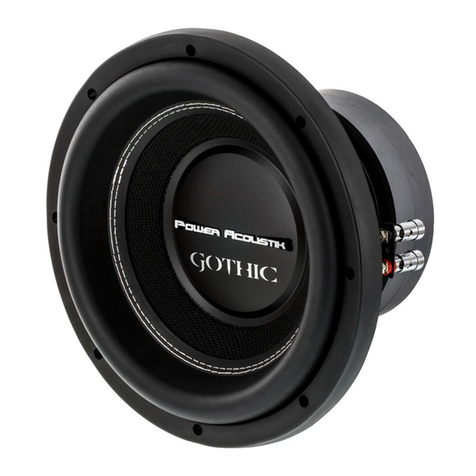
PowerAcoustik
PowerAcoustik Gothic GW3-10 manual
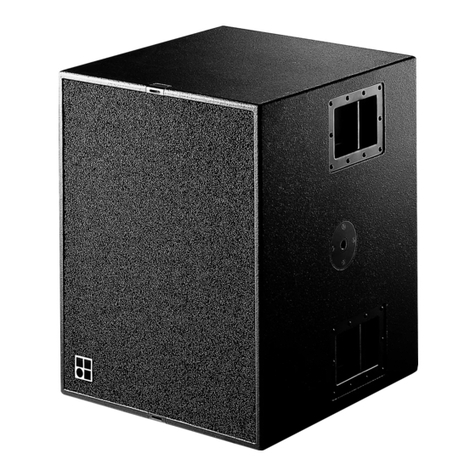
d & b audiotechnik
d & b audiotechnik C7-SUB manual

Speed Link
Speed Link REFLEX 2.1 SL-8217 Quick install guide

Power bass
Power bass XL-844 Application guide
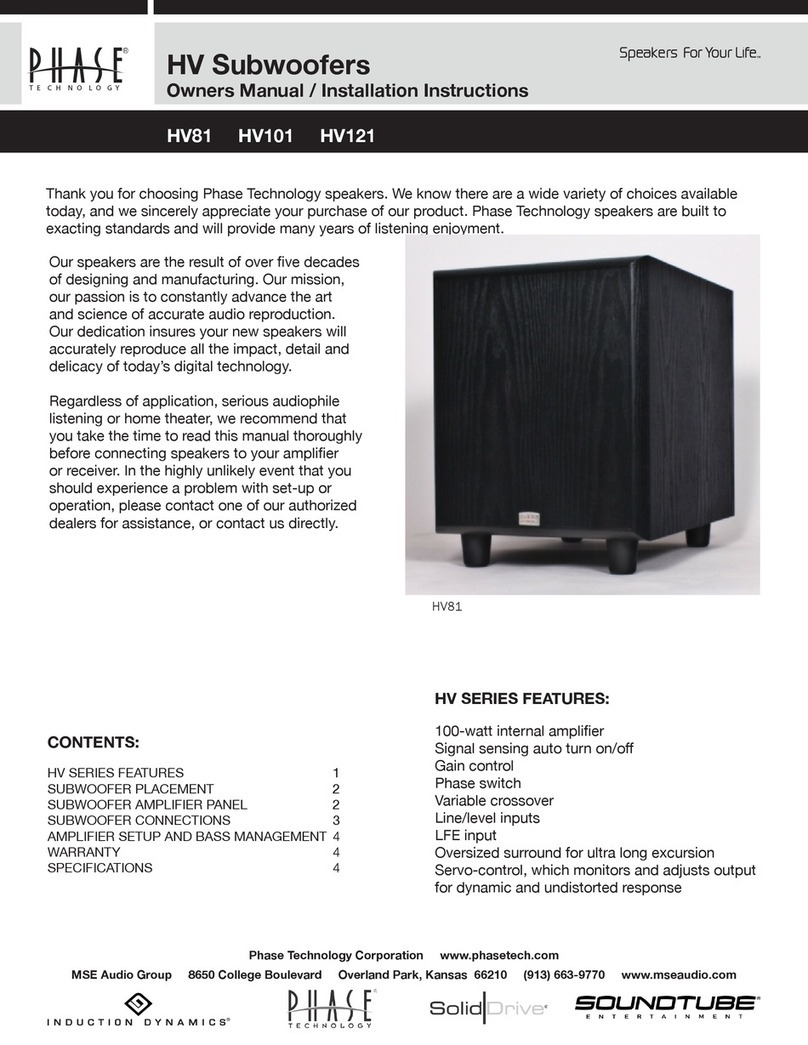
Phase Technologies
Phase Technologies HV101 Owner's Manual & Installation Instructions
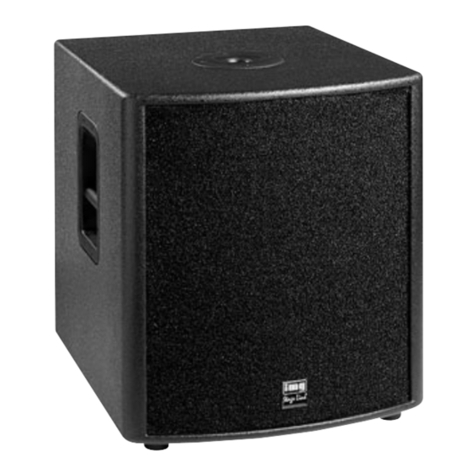
IMG STAGE LINE
IMG STAGE LINE PSUB-215 instruction manual
